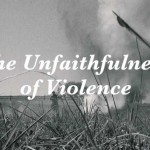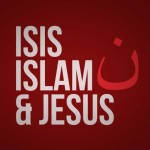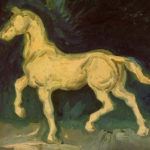We run our website the way we wished the whole internet worked: we provide high quality original content with no ads. We are funded solely by your direct support. Please consider supporting this project.
How Revelation Uses Violent Images in an Anti-Violent Way
All the violent scenes in Revelation are symbols for the battle of truth and deception. They never involve literal violence. In fact, they symbolize ANTI-VIOLENCE. The ingenious way John helps us get free of deception of trust in violent power is by taking a standard violent symbol and juxtaposing it with a symbol that undermines its violence and reverses its violent meaning.
An interesting example of this is when John introduces the mysterious 144,000, which represent the army that fights with the Lamb. They are introduced in Revelation 7: 4: “Then I heard the number of those who were sealed: 144,000 from all the tribes of Israel.”
The 144,000 was a well known Jewish symbol of the army that would accompany the Messiah in a violent uprising against Israel’s foes to restore Israel to its place as a sovereign nation.
But this image of violence gets turned on its head. One example of this is found in Revelation 7:14: “These are they who have come out of the great tribulation; they have washed their robes and made them white in the blood of the Lamb.”
If you read Revelation literally, you have to wonder how washing a robe in blood could make it white. Taken literally its absurd, but interpreted symbolically its profound because this washing of the robes is a Jewish military metaphor.
To be covered with another’s blood rendered you ceremonially unclean, so when Jewish warriors came back from battle covered with the blood of their enemies, they had to go through a purification bathing process before they could reenter society. Instead of washing OFF the blood of foes to become clean, these warriors are made clean by being washed IN blood – and it’s the blood of the one they followed into battle!
Many scholars believe John is not simply saying their sins are washed away by the blood of the lamb, though that is of course true. He is also saying that this army wears white linen because they shared in the blood of the Lamb.
They were willing to suffer with Christ. As it says in chapter 14, this 144,000 was willing to “follow the lamb wherever he goes,” even to the cross. While the standard image of the army of 144,000 following their messiah into battle was based on Babylon’s sword power, John has turned it on its head to communicate slain lamb power — the power of self-sacrificial love.
We are indeed part of an army, but not one that wins by shedding blood: we win by shedding our blood, just as Jesus did.
Category: General
Tags: Book of Revelation, Cruciform Theology, Non-Violence, Violence
Related Reading

Black Lives Matter, the Police, and Spiritual Warfare
Christ calls us to stand for a different kind of kingdom and this requires that we think in different ways about the violence that is gripping our country. In this short clip from Greg’s sermon this last weekend, we are introduced to a different way. Listen and hear the challenge to understand the deeper reality…

The Unfaithfulness of Violence
For more videos like this be sure to visit The Work of the People.

ISIS, Islam & Jesus
http://youtu.be/7W5NWWFFJMg?list=PLB5r2P47beqLlY3wM6VKjwEEofXAZ4lX5 Our friend Bruxy taught a series at The Meeting House titled ISIS, Islam & Jesus that we wanted to share with you. This is episode one, and you can find the whole series by clicking here. If you believe in redemptive violence, you’ll be challenged by what he has to say.

Did Yahweh Crush His Son?
Though Isaiah was probably referring to the nation of Israel as Yahweh’s “suffering servant” when these words were penned, the NT authors as well as other early church fathers interpreted this servant to be a prophetic reference to Christ. Speaking proleptically, Isaiah declares that this suffering servant was “punished” and “stricken by God” (Isa 53:4,…

God’s Kind of Warfare
Over and over, and in a variety of different ways, we are told that, while “[s]ome trust in chariots and some in horses,” Israelites were to “trust in the name of the LORD our God” (Ps 20:7), for “[n]o king is saved by the size of his army” and “no warrior escapes by his great…

God’s Aikido Way of Defeating Evil
Greg continues his thoughts on the atonement with this installment highlighting the way God uses the evil intentions and actions of his enemies to bring about good. And because this strategy is based in love, the demons who encountered Christ could not possibly imagine what he was up to. They ended up participating in their…
